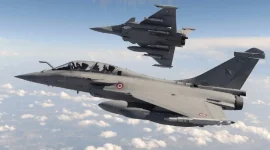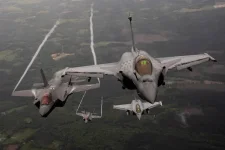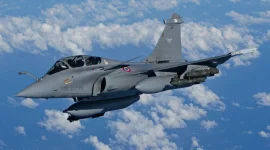- Views: 1K
- Replies: 8
French aerospace leader Dassault Aviation has substantially strengthened its proposal for the Indian Air Force’s (IAF) upcoming Multi-Role Fighter Aircraft (MRFA) tender by establishing major industrial partnerships in India.
A landmark agreement with Tata Advanced Systems Limited (TASL) to manufacture Rafale fighter jet fuselages and a commitment from engine maker Safran to create a comprehensive maintenance facility in India significantly enhance the Rafale's standing in the competition to supply 114 new aircraft.
These developments align with the Indian government's "Make in India" and "Atmanirbhar Bharat" policies, positioning Dassault not just as a seller but as a strategic partner in developing India's indigenous aerospace and defence ecosystem.
On June 5, 2025, Dassault Aviation and TASL officially signed agreements to produce Rafale fuselages at a new facility in Hyderabad. This marks the first time that this critical airframe component will be manufactured outside of France.
The state-of-the-art plant is scheduled to deliver its first fuselage sections in 2028, with a projected production capacity of up to two complete fuselages per month, or 24 annually.
This capacity will support India’s existing Rafale fleet, potential new orders under the MRFA program, and also integrate India into Dassault’s global supply chain.
The facility will produce key sections of the fuselage for both the IAF variant and the Rafale-M jets for the Indian Navy.
This manufacturing agreement follows the nearly €7 billion deal signed in April 2025 for 26 Rafale-M naval fighters, which included provisions for Transfer of Technology (ToT) to establish local production. This ensures that a portion of the naval jets will be equipped with fuselages made in India.
The new Tata partnership builds upon an existing industrial footprint. Dassault Reliance Aerospace Limited (DRAL), a joint venture in Nagpur established in 2016 as part of offset obligations from the initial 36 Rafale deal, already produces components like wings and smaller fuselage sections.
Learning from past negotiations, Dassault is reportedly moving to take full ownership of the DRAL venture to ensure stringent quality control and streamline operations ahead of the MRFA tender.
This move is seen as a way to avoid potential disagreements over production standards, an issue that contributed to the collapse of the earlier Medium Multi-Role Combat Aircraft (MMRCA) tender a decade ago.
Further boosting the French proposal, Safran, the manufacturer of the Rafale's powerful M-88 engine, has committed to establishing a full-fledged Maintenance, Repair, and Overhaul (MRO) facility in Hyderabad. This will be the first MRO hub for the M-88 engine outside of France and is a critical step towards India’s strategic autonomy.
The facility will service the engines for India's entire Rafale fleet, including the 36 jets with the IAF and the 26 on order for the Navy, as well as the potential 114 MRFA jets. Safran's offer includes significant ToT, enabling local expertise in maintaining the high-performance engine.
This integrated approach extends beyond engines. The MRO ecosystem will also support the Rafale's advanced sensors, including the Thales RBE2 AESA radar, and its sophisticated weapons package, such as the Meteor and SCALP missiles.
This comprehensive support structure enhances the operational readiness and long-term sustainability of the Rafale in Indian service.
Rafale's Advantage in a Competitive Field
The MRFA tender, estimated to be worth over $20 billion, is crucial for the IAF to overcome a significant shortfall in its fighter squadrons, which currently stand at around 31 against a sanctioned requirement of 42.While the Rafale faces strong competition from American aircraft like the F/A-18 Super Hornet and F-21 (an India-specific F-16 variant), Sweden's Gripen, the Eurofighter Typhoon, and Russian jets, it holds several key advantages:
- Established Ecosystem: With the IAF and Indian Navy already operating or set to operate the Rafale, the logistical and training infrastructure is already in place, reducing integration costs and timelines.
- Commitment to 'Make in India': The high-value deals with Tata for fuselage manufacturing and Safran for engine MRO demonstrate a deep commitment to local production, a core requirement of the tender.
- Proven Strategic Partnership: France has historically been a reliable partner for India in sharing advanced defence technology, offering a smoother path for ToT compared to the stricter export control regimes of other nations.
- Scalable Production: The combined capacity of the new Hyderabad facility and the existing DRAL plant in Nagpur provides a credible roadmap for delivering 114 aircraft within the IAF's required timeframe.
The Rafale is a high-cost platform, and analysts will be watching to ensure that the "Make in India" initiatives result in genuine technology transfer rather than mere assembly of imported kits.
Furthermore, Dassault's own production lines in France are facing pressure from a backlog of international orders, which could impact its ability to support the ambitious production timelines proposed for India.




